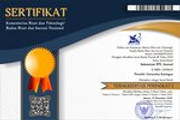LEARNING HOW TO BE POLITE THROUGH A MOVIE: A CASE ON BROWN AND LEVINSON’S POLITENESS STRATEGIES
Abstract
This research discusses politeness strategies at the Tinkerbell movie. The purpose of this study is to analyze the types of politeness strategies, to determine the most dominant types of politeness strategies and to determine the factors that influence the selection of politeness strategies contained in the Tinkerbell Film. This research uses theory by Brown and Levinson (1987). The research method is descriptive qualitative research with content analysis, because the data are collected from documents. There are several steps in collecting data, such as: searching, downloading, watching and listening, transcribing. The results showed 20 politeness strategies found in Tinkerbell Movie, such us: bald on-record 2 (10%), positive politeness 13 (65%), negative politeness 3 (15%), and off-record 2 (10%). The most dominant type of politeness strategy found in Tinkerbell movie is positive politeness. Factors that influence the selection of politeness strategies contained in the Tinkerbell movie are circumstances. Circumstances related to sociological variables included relative power of 6 (30%) and social distance of 14 (70%). Relative power (P) uses a greater degree of politeness with other people who have higher power or authority. Social distance (D) is seen as a composite of psychological factors such as status and age. In conclusion, with this research we must be careful when using language to communicate with other people so that the conversation goes well.
Keywords: pragmatics; politeness strategies; movie.
Full Text:
PDFReferences
Aulia, P., Marliani, R., & Suryani, L. (2019). An analysis on record politeness of pragmatic in Tinker Bell and the great fairy rescue movie. PROJECT (Professional Journal of English Education), 2(6), 811-815.
Arikunto, S. (2010). Prosedur penelitian suatu pendekatan praktik. Jakarta: Rineka Cipta, Cet. Ke-13.
Ary, D., Jacobs, L. C., Sorensen, C., & Razavieh, A. (2010). Introduction to research in education 8th edition. Belmont, California: Wadsworth.
Brown, P., & Levinson, S. C. (1987). Politeness: Some universals in language usage (Vol. 4). UK: Cambridge university press.
Creswell, J. W. (2014). A concise introduction to mixed methods research. SAGE publications.
Fitria, H., Ningrum, D. R., & Suhandoko, S. (2020). Politeness strategies reflected by the main character in “Bridge to Terabithia” movie. Etnolingual, 4(1), 57-70.
Herman. (2015). Illocutionary acts analysis of Chinese in Pematangsiantar. International Journal of Humanities and Social Science Invention, 4(12), 41-48.
Herman., & Pardede, H. (2020). Deixis analysis in the business article of the jakarta post. Wanastra: Jurnal Bahasa dan Sastra, 12(2), 2579-3438. DOI: 10.31294/w.v12i2.8464
Hutahaean, D. T., Herman., and Girsang, A. F. F. (2021). An analysis of politeness strategies found in pesbukers variety show. Wanastra: Jurnal Bahasa dan Sastra, 13(1), 39-46. DOI: 10.31294/w.v13i1.9218
Pardede, H., Herman., & Pratiwi, W. (2019). An analysis of politeness principle maxims found in Big Hero 6 movie. European Exploratory Scientific Journal, 3(4), 1-7.
Pardede, H., Herman, and Manurung, E. T. R. (2021). An analysis of politeness strategies in garis tangan reality show. American Journal of Social and Humanitarian Research, 2(2), 1-19. DOI: https://doi.org/10.31150
Purba, R., Herman, H., Manullang, V. R. M., and Ngongo, M. (2021). Investigation of decoding fillers used in an English learning talk show “English with Alice”. English Review: Journal of English Education, 10(1), 37-48. https://doi.org/10.25134/erjee.v10i1.5352
Purba, R., Herman, H., Purba, A., Hutauruk, A. F., Silalahi, D. E., Julyanthry, J., and Grace, E., (2022). Improving teachers’ competence through the implementation of the 21st century competencies in a post-covid-19 pandemic. Jurnal Masyarakat Mandiri, 6(2), 1486-1497. DOI: https://doi.org/10.31764/jmm.v6i2.7340
Saragih, D. Y., Sinaga, Y. K., Herman, Purba, R., Saragi, C. N., and Manurung, L. W. (2022). The analysis of directive illocutionary acts on some conversations in the miracle worker movie. Sarcouncil Journal of Arts and Literature, 1(2), 1-8. https://doi.org/10.5281/zenodo.6519387
Sianturi, O., Saragih, Y. E., Sinaga, Y. K., & Herman. (2021). An analysis of speech act found in Bernie Sander’s speech: A pragmatics case. International Journal of Culture and Modernity, 9, 105–114.
Simaremare, Y. N., Nainggolan, W. C., and Herman. (2021). Pragmatics analysis on conversational implicature used in Mulan (2020) movie. Middle European Scientific Bulletin, 15, 64-74. DOI: https://doi.org/10.47494/mesb.2021.15.696
Vanderstoep, S. W., & Johnson, D. D. (2008). Research methods for everyday life: Blending qualitative and quantitative approaches (Vol. 32). John Wiley & Sons.
Van Thao, N., Purba, P. M., and Herman. (2021). Pragmatics analysis on commisive speech act in a movie. European Journal of Humanities and Educational Advancements, 2(7), 70-74.
Wang, Y. (2010). Analyzing Hedges in verbal communication: An adaptation-based approach. English Language Teaching, 3(3), 120-124.
DOI: https://doi.org/10.25134/ieflj.v8i2.6438
Refbacks
- There are currently no refbacks.

This work is licensed under a Creative Commons Attribution-ShareAlike 4.0 International License.

